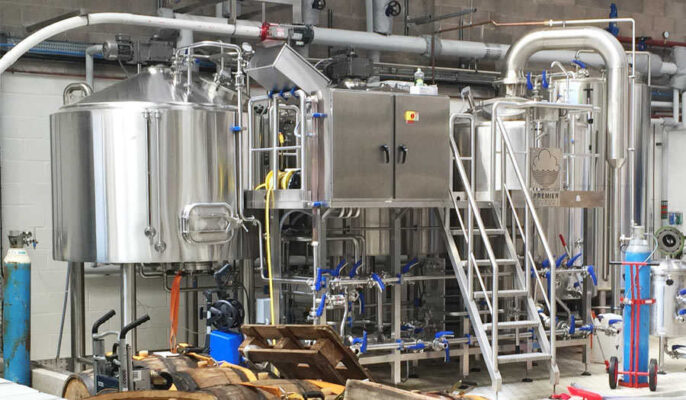What is the difference between a two-can brewery and a three-can brewery? A brewery is made up of many containers, each with a specific purpose. Breweries are set up . For small volumes less than 1000L, you may need 2vessel type, as well as 3 vessel type. But for a volume of more than 2000 liters per batch, 4 vessel types are required for brewing.
What is a 2 vessel brewing system?
A 2-vessel brewing system is a type of brewing equipment used by home brewers and small commercial breweries to brew beer. As the name suggests, it consists of two vessels – a mash/lauter tun and a brew kettle.
Brewhouse/lauter tun
The mashing/lauter tun is used in the mashing process, in which hot water is added to sprouted grains to extract the sugars. The resulting mixture is then drained through a perforated trap to separate the liquid wort from the stillage.
Kettle/whirlpool
Where the wort is boiled and hops are added to impart bitterness, flavor and aroma to the beer. After boiling, the wort is transferred to a whirlpool, where it is swirled to separate the hot lysates from the wort, then cooled and transferred to fermenters.

What is a 3 vessel brewing system?
There are a variety of different systems and equipment to choose from when it comes to brewing beer, but one of the most popular and used setups is the 3-vessel brewing system. The system consists of three main components: the mash tun, lauter tun and kettle. The 3-vessel brewing system offers several advantages over other brewing systems. With more precise temperature control during mashing, the overrun also provides a better separation of the wort from the stillage, and the product ends up being cleaner and clearer.
3 Vessel brewing systems are an important tool for small breweries to produce high-quality craft beer. It provides greater control and consistency, which translates into a better end product for beer lovers to enjoy.
Mash barrel
Here the grains are mixed with hot water to start the mashing process, which extracts the sugars and ferments them into alcohol. The temperature is usually maintained between 148 and 158 degrees Fahrenheit to ease the enzyme activity required for the sugar extraction process. The mash tun is an important part of the brewing process, responsible for extracting the sugar that will become the alcoholic content of the beer. Its precise temperature control and thorough mixing ensure a consistent end product batch after batch.
Filter bucket
The lauter tun is the second vessel in a 3-vessel brewing system and handles separating the liquid wort from the spent grains after the mashing process. After the mashing process is complete, the syrup is transferred to a lauter tun where the liquid is separated from the solid particles through a process called lautering.
Liquid wort is drained from the mash tun and filtered through a bed of spent grains called a grain bed. This process helps to clarify the wort and remove any impurities, resulting in a cleaner final product.
Kettle
The kettle is the last vessel in the 3-vessel brewing system, where the liquid wort is boiled, hops and other ingredients are added, and the final flavor of the beer is developed.
During the boiling process, the wort is sterilized and hops and other ingredients are added. The boiling process extracts hop bitterness and other flavors and aromas, giving beer its unique taste and aroma. The length and intensity of the boil can also affect the final flavor profile as well as the color of the beer.
The difference between 2 vessel and 3 vessel breweries
When choosing between 2 vessel and 3 vessel, there are a few things to consider:
Annual output
2 Vessel breweries are generally suitable for small and medium-sized breweries below 10,000 barrels. The 3 vessel brewery is more suitable for large breweries with an annual output of more than 10,000 barrels of beer.
Advantage
2 vessel breweries are simple and cost-effective, requiring less space and area, meaning lower capital costs and lower operating costs.
3 vessel brewery flexibility and control over the brewing process. A 3 vessel brewhouse requires more space and more vessels, which means higher capital costs and higher operating costs.
Production capacity
A 3 vessel brewery is more efficient than a 2 vessel brewery, with higher output and better beer quality. For larger breweries, a 3 vessel brewery can provide a better return on investment in the long run.
Choose the right brewery
Choosing between 2 vessel or 3 vessel depends on the size of the brewery, the type of beer to be brewed, and your budget. The right brewhouse for your brewery is the one that best meets your needs and goals as a brewer.




